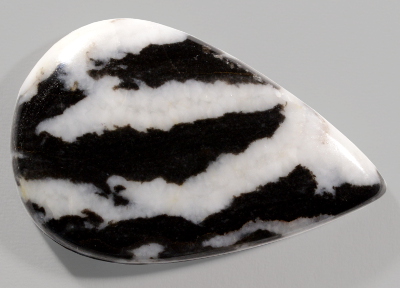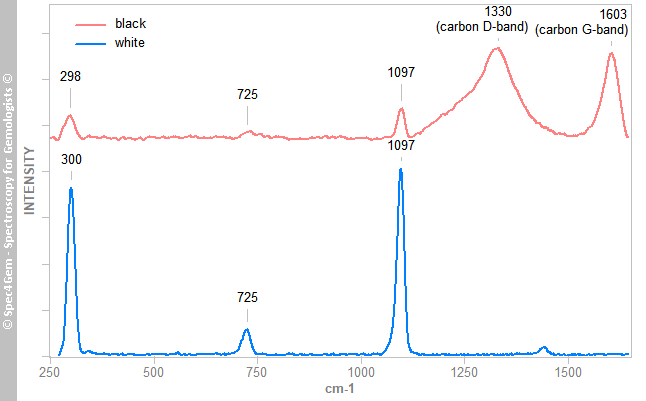Zebra 'jasper' - a black and white marble
- Details
- Created: Saturday, 13 July 2024 10:59
The black and white zebra-striped cabochon (Figure 1) represents a gemstone material which is available as cabochons or tumbled stones. It is quite attractive with its zebra-striped pattern and its sub-vitreous luster. It is commercially available as a zebra jasper or a zebra marble (zebra marmor in german) reportedly coming from Brazil or USA. The specific gravity of this cabochon is 2.64 that possibly misleads the identification with quartz hence the identification as 'jasper'. The RI, which is approximately arround 1.63 or higher, does not match with 'jasper'. Non-destructive Raman spectroscopy was used to correctly identify the gemstone.
 Figure 1. 37.96 ct black and white zebra-striped cabochon, an
Figure 1. 37.96 ct black and white zebra-striped cabochon, an alternating of black and white dolomitic marble.
| Shape | pear cabochon |
| Size | 34.9 x 22.5 x 5.8 mm |
| Color | black and white |
| Diaphaneity | black material is opaque, white material is translucent |
| Lustre | sub-vitreous |
| Weight | 37.96 ct |
| SG | 2.64 |
| RI | ~1.63 or higher |
| DR | - |
| Pleochroism | - |
| Polariscope / Conoscope | - |
| SWUV | white material luminesces and phosphoresces (few seconds) beige with some white, black material is inert |
| LWUV | white material luminesces and phosphoresces (few seconds) beige with some white, black material is inert |
| Magnetic susceptibility N52 | diamagnetic |
| Chelsea filter | black and white, inert |
Table 1. Observational and measured properties
Raman spectroscopy:
Raman spectra (Figure 2) were collected from two distinct spots, one in the white material of the cabochon (blue spectrum) and another one in the black material (red spectrum). White material spectrum shows dolomite's characteristics Raman peaks at 300, 725 and 1097 cm-1. The black material is as the white one composed of dolomite (Raman peaks at 298, 725 and 1097 cm-1) but it contains also some carbon (or carbonated compounds) revealed by the typical Raman peaks at 1330 and 1603 cm-1, respectively known as the D- and G-bands (Brolly et al. 2015[1]).
 Figure 2. Raman spectra of white material (blue spectrum) and black material (red spectrum) layered in the cabochon. Both materials are composed of dolomite (300, 725 and 1097 cm-1) and the black one seems to be colored by carbon (1330 and 1603 cm-1).
Figure 2. Raman spectra of white material (blue spectrum) and black material (red spectrum) layered in the cabochon. Both materials are composed of dolomite (300, 725 and 1097 cm-1) and the black one seems to be colored by carbon (1330 and 1603 cm-1).Conclusion:
This 37.96 ct black and white zebra-striped cabochon is definitely a dolomitic marble as shown by Raman spectroscopy and not a jasper. Its black color is caused by carbon or carbonated compounds.

